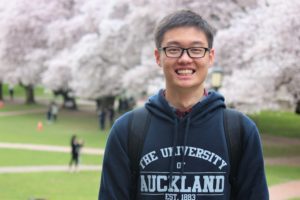Meet Statistics Summer Scholar Xin Qian
Every summer, the Department of Statistics offers scholarships to high-achieving students so they can work with staff on real-world projects. Xin Qian, in the picture, is working with Dr Ben Stevenson, an expert in statistical methods for estimating animal populations.
is working with Dr Ben Stevenson, an expert in statistical methods for estimating animal populations.
How can you work out how many creatures inhabit a space when they are elusive, small and have lots of places to hide? Sitting in the bush for months and trying to count what you hear won’t be accurate – and it’s probably not a good use of time.
Another way is to estimate animal abundance is through acoustic surveys, which use microphone arrays to record animal chirps and calls; statistical techniques are then used to estimate the population. This is called spatial capture-recapture (SCR), and at present we have several ways of analysing the data.
That’s where summer student Xin Qian comes in. He is working with SCR expert Dr Ben Stevenson on a simulation project that compares two ways of analysing acoustic data. They are using statistics gathered from surveys of the rare moss frog, which exists only on South Africa’s Cape Peninsula.
“We want to find out which is the best method for providing an accurate and stable estimation of frog density, factoring in the time each method takes,” says Xin. The existing method, he explains, requires that you go and collect independent data about how often individual frogs chirp in order to estimate animal density, which takes time.
However, the new method, developed by Ben Stevenson’s former MSc student Callum Young, promises to estimate both call rates and therefore animal density from the main survey alone. Says Ben: “This can save time, but may possibly leave you with a less accurate answer. What we are hoping to do is resolve the trade-off. How is the precision of our estimates affected if we switch to the new method? My guess is that it will be worse. Is this sacrifice worth the saving in fieldwork time?”
For this work they are using R, a programming language for statistical computing and graphics developed in the Department of Statistics in the mid-1990s and now used all over the world.
The project is ideal for Xin, a third-year University of Auckland BSc student majoring in Statistics and Information Systems. “It is always interesting to get information from data; it makes me feel like I am having some secret conversation with data that people can’t hear,” he says. “I normally won’t get bored dealing with numbers, and I prefer things having a logic or a reason behind them.”
Xin was born and raised in China, in the small east-coast city of Jiaxing near Shanghai. After finishing secondary school in China, he moved to New Zealand to pursue tertiary studies, starting his degree in 2016.
The University of Auckland appealed to him “because of its good reputation and ranking.” Although education rather than environment drew him to this country, he says that “New Zealand is a beautiful place with splendid natural views, and most people here are nice and welcoming; I have made lots of friends here. I have also became more outgoing and willing to try various outdoor activities that I wouldn’t get a chance to try if staying in my hometown.”
- For general information on University of Auckland summer scholarships, click here.
Atakohu Middleton is an Auckland journalist with a keen interest in the way the media uses/abuses data. She happens to be married to a statistician. See all posts by Atakohu Middleton »